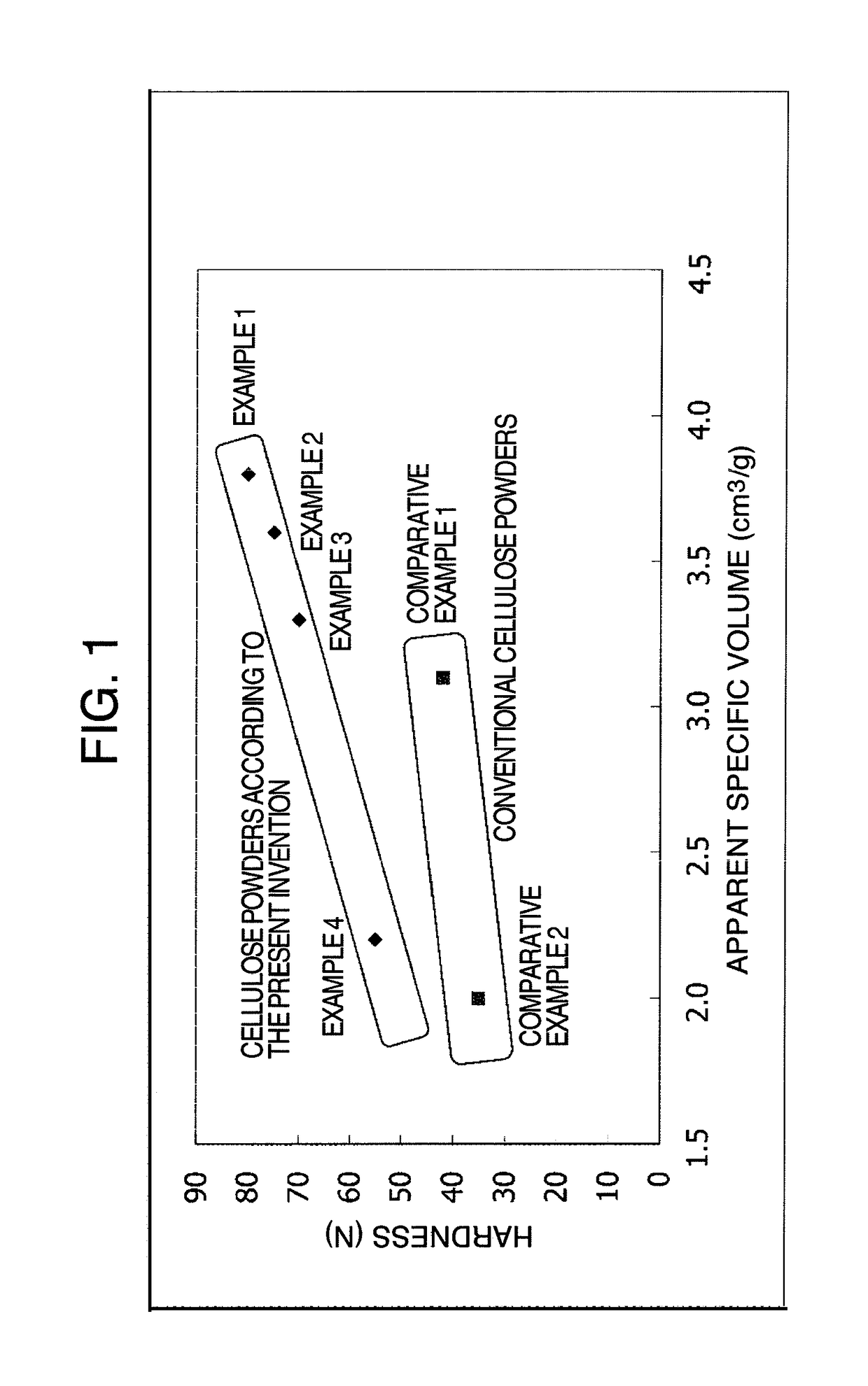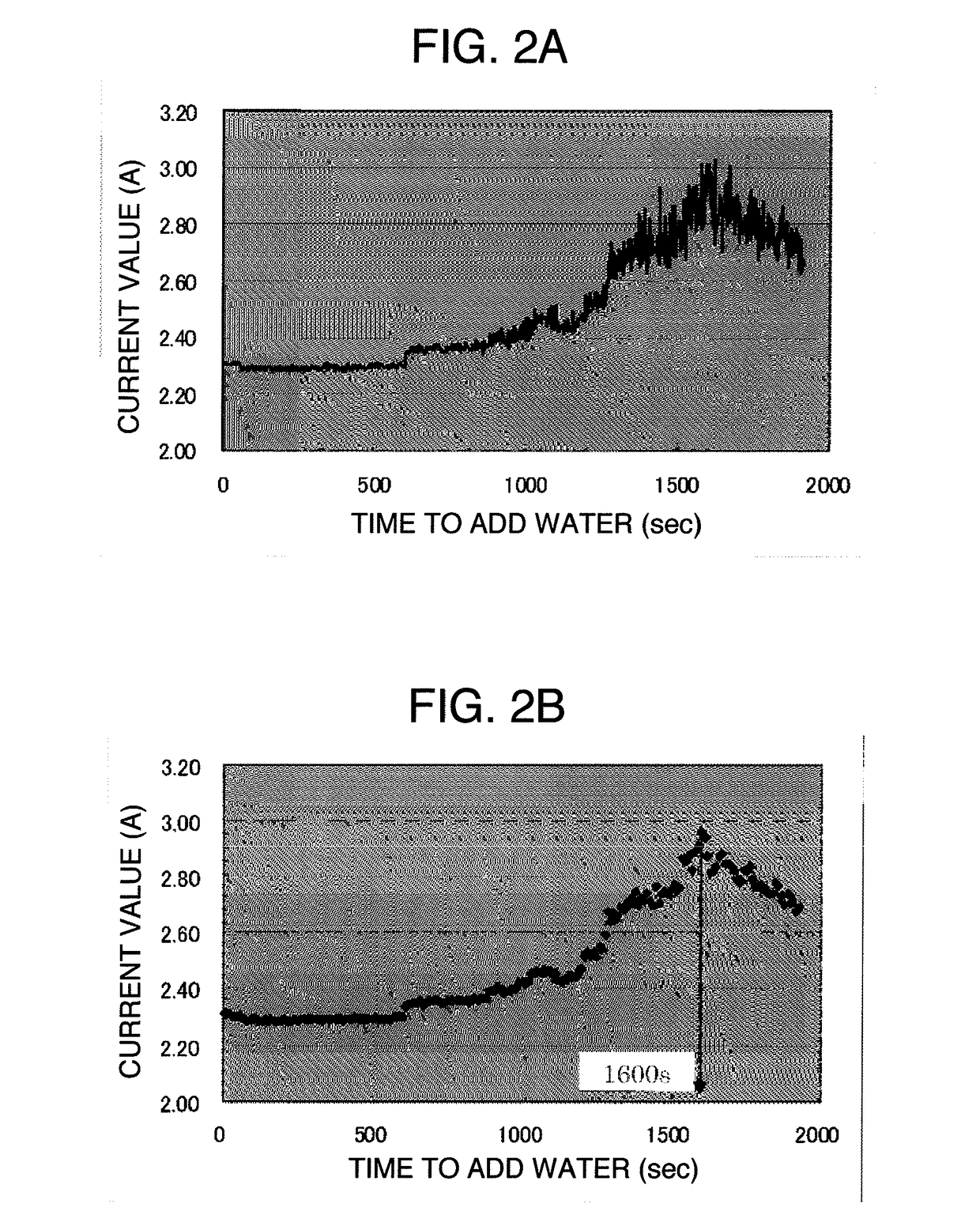Cellulose powder
a technology of cellulose powder and cellulose powder, which is applied in the field of cellulose powder, can solve the problems of difficult administration, bulky and compounded kampo medicines, and increase the size of tablets prepared, and achieves stable disintegration properties over time, reduce disintegration time, and high compression compactibility
- Summary
- Abstract
- Description
- Claims
- Application Information
AI Technical Summary
Benefits of technology
Problems solved by technology
Method used
Image
Examples
example 1
[0142]2 kg of a commercially available SP pulp (degree of polymerization: 1030, level-off degree of polymerization: 220) was shredded, and was added to 30 L of an aqueous solution of 0.05% hydrochloric acid. While the mixture was stirred (at a stirring rate of 234 rpm) with a low speed stirrer (manufactured by Ikebukuro Horo Kogyo Co., Ltd., 30 LGL reactor, blade diameter: about 30 cm), the pulp was hydrolyzed at 145° C. for 70 minutes. The resulting acid-insoluble residues were filtered with a suction funnel. The filtered residues were washed with 70 L of pure water 4 times, and were neutralized with aqueous ammonia. The residues were placed in a 90 L plastic bucket, and pure water was added. While the mixture was stirred (at a stirring rate of 500 rpm) with a three-one motor (manufactured by HEIDON, type BLh1200, 8 MIM, blade diameter: about 10 cm), a cellulose dispersion liquid having a concentration of 16% was prepared (pH: 7.8, IC: 55 μS / cm).
[0143]The cellulose dispersion liqui...
example 2
[0144]2 kg of a commercially available SP pulp (degree of polymerization: 1030, level-off degree of polymerization: 200) was shredded, and was added to 30 L of an aqueous solution of 0.08% hydrochloric acid. While the mixture was stirred (at a stirring rate of 234 rpm) with a low speed stirrer (manufactured by Ikebukuro Horo Kogyo Co., Ltd., 30 LGL reactor, blade diameter: about 30 cm), the pulp was hydrolyzed at 140° C. for 110 minutes. The resulting acid-insoluble residues were filtered with a suction funnel. The filtered residues were washed with 70 L of pure water 4 times, and were neutralized with aqueous ammonia. The residues were placed in a 90 L plastic bucket, and pure water was added. While the mixture was stirred (at a stirring rate of 500 rpm) with a three-one motor (manufactured by HEIDON, type BLh1200, 8 M / M, blade diameter: about 10 cm), a cellulose dispersion liquid having a concentration of 18% was prepared (pH: 7.5, IC: 60 μS / cm).
[0145]The cellulose dispersion liqu...
example 3
[0146]2 kg of a commercially available KP pulp (degree of polymerization: 1030, level-off degree of polymerization: 190) was shredded, and was added to 30 L of an aqueous solution of 0.10% hydrochloric acid. While the mixture was stirred (at a stirring rate of 234 rpm) with a low speed stirrer (manufactured by Ikebukuro Horo Kogyo Co., Ltd., 30 LGL reactor, blade diameter: about 30 cm), the pulp was hydrolyzed at 135° C. for 100 minutes. The resulting acid-insoluble residues were filtered with a suction funnel. The filtered residues were washed with 70 L of pure water 4 times, and were neutralized with aqueous ammonia. The residues were placed in a 90 L plastic bucket, and pure water was added. While the mixture was stirred (at a stirring rate of 500 rpm) with a three-one motor (manufactured by HEIDON, type BLh1200, 8 M / M, blade diameter: about 10 cm), a cellulose dispersion liquid having a concentration of 19% was prepared (pH: 7.5, IC: 50 μS / cm).
[0147]The cellulose dispersion liqu...
PUM
| Property | Measurement | Unit |
|---|---|---|
| weight average particle size | aaaaa | aaaaa |
| weight average particle size | aaaaa | aaaaa |
| specific volume | aaaaa | aaaaa |
Abstract
Description
Claims
Application Information
 Login to View More
Login to View More - R&D
- Intellectual Property
- Life Sciences
- Materials
- Tech Scout
- Unparalleled Data Quality
- Higher Quality Content
- 60% Fewer Hallucinations
Browse by: Latest US Patents, China's latest patents, Technical Efficacy Thesaurus, Application Domain, Technology Topic, Popular Technical Reports.
© 2025 PatSnap. All rights reserved.Legal|Privacy policy|Modern Slavery Act Transparency Statement|Sitemap|About US| Contact US: help@patsnap.com


